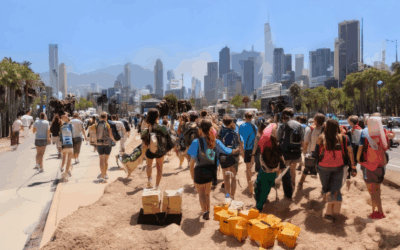For those seeking meaningful experiences that combine travel, cultural immersion, and community development, volunteer service trips abroad offer a unique opportunity to make a positive impact while exploring new destinations. With numerous options available, from short-term missions to long-term volunteer programs, individuals can choose from a wide range of projects and locations that cater to their interests, skills, and availability. Whether it’s working on conservation efforts in Africa, teaching English in Asia, or assisting with disaster relief in Latin America, volunteer service trips provide a chance to engage with local communities, learn about different cultures, and develop valuable skills that can benefit both personal and professional lives.

Cost of Volunteer Trips
The cost of volunteer trips can vary greatly depending on several factors, including the destination, type of project, duration, and organization.
-
Program Fees:
Many organizations charge program fees, which cover expenses such as accommodation, meals, and project-related costs.
- Volunteering Solutions’ most popular programs average around $350 per week.
- Projects Abroad’s volunteer programs average around $1,388 per week.
-
Accommodation Costs:
Some organizations may charge extra for accommodation, while others may include it in the program fee.
- Hostel-style accommodation can cost between $50-$100 per week.
- Shared apartments or homestays can cost between $150-$300 per week.
-
Food and Transportation Costs:
Volunteers may need to budget for food and transportation costs, which can vary depending on the location and mode of transport.
- Meals can cost between $10-$20 per day.
- Public transportation can cost between $1-$5 per ride.
-
Other Expenses:
Volunteers may also need to budget for other expenses such as visa fees, vaccinations, and equipment.
- Visa fees can cost between $50-$200.
- Vaccinations can cost between $50-$100.
- Equipment costs can vary depending on the project requirements.
Overall, the total cost of a volunteer trip can range from a few hundred dollars to several thousand dollars, depending on the specifics of the program.
It’s essential to research and compare prices among different organizations to find the best option for your needs and budget.
Can You Travel for Free by Volunteering?
While traveling for free through volunteering might seem like a myth, there are indeed opportunities available that can help you save money on your trips.
- One option is to participate in work-exchange programs, where you trade your skills or labor for accommodation and sometimes meals.
- Another approach is to join volunteer programs that offer free or low-cost accommodations, often in exchange for your time and effort.
Understanding the Costs Involved
When considering volunteering as a means to travel for free, it’s essential to understand that you’ll still need to cover certain expenses, such as:
- Flights to and from your destination
- Travel insurance to protect yourself against unexpected events
- Vaccinations and medications required for your trip
Exploring Volunteer Opportunities
To find volunteer programs that align with your interests and budget, consider the following options:
- Research organizations that offer free or low-cost volunteer opportunities, such as Habitat for Humanity or the Peace Corps
- Look into work-exchange programs, like Workaway or WWOOF, which connect travelers with hosts who need assistance in exchange for room and board
- Join online communities, like Volunteer Forever or Go Overseas, to connect with other travelers and learn about volunteer opportunities
Tips for Successful Volunteering
To make the most of your volunteer experience and minimize costs, keep the following tips in mind:
- Research thoroughly to find programs that fit your skills, interests, and budget
- Budget accordingly for expenses, such as flights and vaccinations
- Be flexible and open-minded when working with hosts or fellow volunteers
Conclusion is Not Required

Examples of Volunteer Tourism
I’ve had the opportunity to participate in various volunteer tourism projects around the world, and I’m excited to share some examples with you.
- Wildlife Conservation: Many organizations offer opportunities to work with animals in need, such as elephant sanctuaries in Thailand or wildlife rehabilitation centers in South Africa.
- Community Development: Volunteering in communities affected by poverty or natural disasters can be a rewarding experience, such as building homes in Haiti or teaching English in Cambodia.
- From beach cleanups in Costa Rica to reforestation efforts in Kenya, there are countless ways to make a positive impact on the environment through volunteer tourism.
- Medical Volunteering: Gain hands-on experience in hospitals and clinics around the world, working alongside local healthcare professionals to provide medical care to those in need.
- Educational Programs: Teach English, math, or science to students in developing countries, helping to bridge the educational gap and promote cross-cultural understanding.
- Disaster Relief: Respond to natural disasters and humanitarian crises, providing critical support to affected communities and helping with relief efforts.
These are just a few examples of the many types of volunteer tourism opportunities available. Whether you’re interested in conservation, education, or community development, there’s a project out there for you.
Popular Organizations for Volunteer Tourism
- Projects Abroad
- Volunteer HQ
- World Wide Volunteers
- GoAbroad
When choosing a volunteer tourism organization, consider factors such as their mission, values, and reputation, as well as the type of project and location you’re interested in.
Tips for Getting Started
- Research thoroughly: Look into the organization’s history, reviews, and ratings to ensure you’re making an informed decision.
- Set clear goals: Determine what you hope to achieve through your volunteer experience and choose a project that aligns with your goals.
- Plan ahead: Book your trip well in advance to secure a spot on your chosen project and make necessary arrangements.
- Stay flexible: Be open to new experiences and adapt to changing circumstances during your volunteer tour.

Are Mission Trips Volunteer Work?
A mission trip can be considered a type of volunteer work, but it often involves more than just donating time or skills.
- Mission trips typically involve traveling to a foreign country or region to participate in humanitarian efforts, such as building homes, distributing food, or providing medical care.
- These trips often have a spiritual component, with participants seeking to spread their faith or learn about different cultures.
- However, many organizations now offer secular mission trips that focus solely on volunteer work, such as conservation projects or disaster relief efforts.
Key Characteristics of Mission Trips
Mission trips often share certain characteristics that set them apart from traditional volunteer work:
- International travel : Mission trips typically take place outside of the participant’s home country, allowing for cultural immersion and exposure to new experiences.
- Humanitarian focus : These trips aim to address pressing needs in the host community, whether through construction, healthcare, education, or other forms of assistance.
- Spiritual or educational components : Many mission trips incorporate elements of spirituality, faith, or cultural learning, which can enrich the participant’s experience and foster personal growth.
Distinguishing Features of Volunteer Work
While mission trips may overlap with traditional volunteer work, there are distinct differences between the two:
- Variety of activities : Volunteer work can encompass a broad range of tasks, from administrative duties to hands-on labor, whereas mission trips tend to focus on specific projects or initiatives.
- : Volunteer work can be short-term or long-term, whereas mission trips usually require a minimum duration, often ranging from several weeks to several months.
- : Volunteers may work independently or as part of a team, whereas mission trips often involve collaboration with local partners, community leaders, or other travelers.
Conclusion
In summary, while mission trips share some similarities with traditional volunteer work, they possess unique characteristics that distinguish them from other forms of service. By understanding these differences, individuals can better navigate the world of volunteer opportunities and find the perfect fit for their skills, interests, and goals.
Cost of Mission Trips
The cost of a mission trip can vary greatly depending on several factors, including the destination, duration, and type of project.
- A 1-week mission trip to Eswatini can cost around $1,799, while a trip to South Africa may cost approximately $999.
- Mexico is often considered one of the most affordable options, with prices starting at around $675.
- A mission trip to the Bahamas can be relatively inexpensive, with costs ranging from $500 to $1,000.
In general, the cost of a mission trip includes:
- Flights to and from the destination
- Accommodation and meals during the trip
- Project-related expenses, such as materials and equipment
- Travel insurance and medical evacuation coverage
It’s worth noting that some organizations may offer financial assistance or scholarships to help offset the cost of a mission trip.
When planning a mission trip, it’s essential to consider the total cost and factor in any additional expenses, such as visa fees, vaccinations, and travel documents.
Researching and comparing prices among different organizations and destinations can help you find the best option for your budget and goals.
Additionally, many organizations offer package deals or discounts for group bookings, which can help reduce the overall cost of the trip.
Ultimately, the cost of a mission trip will depend on your individual circumstances and priorities.
By doing your research and planning carefully, you can find a mission trip that fits your budget and meets your needs.

What do you call a volunteer trip?
A volunteer trip can be referred to as various names depending on its nature and goals.
- Vacation volunteering : This term describes trips that combine leisure activities with volunteer work, often focusing on the participant’s experience rather than the community’s needs.
- Voluntourism : A portmanteau of “volunteer” and “tourism,” this term encompasses trips that blend travel and volunteer work, sometimes criticized for prioritizing the traveler’s experience over the community’s benefits.
- Service learning : This term emphasizes educational aspects, combining volunteer work with learning experiences, often in a foreign setting.
- Cultural immersion : Trips focused on immersing participants in local cultures through volunteer work, homestays, and community engagement.
- Community development projects : Long-term initiatives aimed at addressing specific community needs, often involving volunteer work and skill-sharing.
When choosing a volunteer trip, consider factors such as project duration, location, and type of work involved, as well as the organization’s reputation and impact on the community.
Key considerations:
- Project duration : Short-term vs. long-term commitments
- Location : Local, national, or international settings
- Type of work : Hands-on tasks, administrative support, or skills-based contributions
- Organization reputation : Research the group’s mission, impact, and reviews
Benefits and drawbacks:
- Benefits: Cultural exchange, skill-building, community engagement, and personal growth
- Drawbacks: Potential cultural insensitivity, lack of meaningful impact, and exploitation concerns
Best practices:
- Research thoroughly : Understand the project’s goals, methods, and expected outcomes
- Choose reputable organizations : Look for groups with a strong track record and transparent operations
- Set realistic expectations : Recognize the limitations and potential challenges of volunteer work
Conclusion:
Volunteer trips can be incredibly rewarding experiences, offering opportunities for personal growth, cultural exchange, and community engagement. However, it’s essential to approach these trips with a critical eye, considering factors such as project duration, location, type of work, and organization reputation. By doing so, travelers can maximize their positive impact and minimize potential drawbacks, ultimately contributing to meaningful and sustainable change.




0 Comments